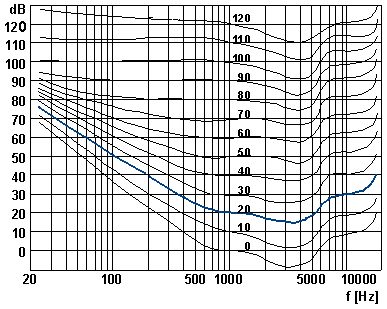|
| |

Understanding dB
dB is an abbreviation for "decibel". One decibel is one tenth of a Bel, named for Alexander Graham Bell.
The measurement quoted in dB describes the ratio
(10 log power difference, 20 log voltage difference, etc.) between the quantity of two
levels, the level being measured and a reference. To describe an absolute value, the reference point must be known. There are
a number of different reference points defined. Here are a few:
 |
dBV represents the level compared to 1 Volt RMS. 0dBV = 1V. There is no
reference to impedance. |
 |
dBu represents the level compared to 0.775 Volts RMS with an unloaded,
open circuit, source (u = unloaded). |
 |
dBm represents the power level compared to 1 mWatt. This is a level
compared to 0.775 Volts RMS across a 600 Ohm load impedance. Note that
this is a measurement of power, not a measurement of voltage. |
 |
dbFS - relative to digital full-scale. |
 |
dB SPL - A measure of sound pressure level. |
A few easy-to-remember facts that may help:
 | If you're dealing with voltage measurments, convert from dBV to dBu: 1dBV equals +2.2dBu. |
 |
+4dBu equals 1.23 Volts RMS. |
 |
The reference level of -10dBV is the equivalent to a level of -7.8dBu. |
 |
+4dBu and -10dBV systems have a level difference of 11.8 dB and not 14 dB.
This is almost a voltage ratio of 4:1 (Don't forget the difference between dBu
and dbV !!) |
dBFS - dB Full Scale
0 dBFS represents the highest possible level in digital gear. All other
measurements expressed in terms of dBFS will always be less than 0 dB (negative
numbers).
0 dBFS indicates the digital number with all digits ="1", the highest
possible sample.
The lowest possible sample is (for instance for 16 bit audio):
0000 0000 0000 0001, which equals -96 dBFS. Therefore the dynamic range
for 16-bit systems is 96 dB. For 20-bit
digital audio it is 120 dB. For 24 bit digital audio it is 144 dB.
Full-scale input level is the analog input voltage level that will cause the A/D
converter to just equal full scale with no clipping on either positive or
negative peaks.
Output full scale is defined as the analog output voltage produced while playing
a 997 Hz digital full-scale sine wave, assuming the THD+N is less than -40 dB
relative to the signal level.
The dynamic range of a digital system is the ratio of the full scale signal level to the RMS noise
floor.
Sound Pressure Level
The definition of dB SPL is the 20 log of the ratio between the measured sound
pressure level and the reference point. This reference point is defined as
0.000002 Newtons per square meter, the threshold of hearing. However, the
threshold of hearing (and sensitivity to level) changes by frequency and for soft
and loud sounds, as discovered by
Fletcher and Munson in 1933, shown in the graph below:

Note that human hearing is relatively insensitive to low bass (below 100 Hz),
and also compresses at higher sound levels.
Here are some typical sounds, and their levels.
| Sounds |
dB SPL |
| Rocket Launching |
180 |
| Jet Engine |
140 |
| Thunderclap, Air Raid Siren 1 Meter |
130 |
| Jet takeoff (200 ft) |
120 |
| Rock Concert, Discotheque |
110 |
| Firecrackers, Subway Train |
100 |
| Heavy Truck (15 Meter), City Traffic |
90 |
| Alarm Clock (1 Meter), Hair Dryer |
80 |
| Noisy Restaurant, Business Office |
70 |
| Air Conditioning Unit, Conversational Speech |
60 |
| Light Traffic (50 Meter), Average Home |
50 |
| Living Room, Quiet Office |
40 |
| Library, Soft Whisper (5 Meter) |
30 |
| Broadcasting Studio, Rustling Leaves |
20 |
| Hearing Threshold |
0 |
The A-weighted sound level represents the human hearing and hearing damage in
the possible best way. Without any other information the A-weighted sound level
is the best information available for measuring noise problems. See the
discussion of A-weighted measurement below and also
see Speech Level.
A-Weighting dB(A), Relationship between Frequency and Level
A standard for noise measurement that takes into consideration the human ear's
sensitivity to certain frequencies. This is expressed as part of noise
specifications and can be denoted by adding the letter 'A' to the spec - i.e.
15dBA.
(Sweetwater Archive)
| 10Hz |
12,5Hz |
16Hz |
20Hz |
25Hz |
31,5Hz |
40Hz |
50Hz |
| -70,4dB |
-63,4dB |
-56,7dB |
-50,5dB |
-44,7dB |
-39,4dB |
-34,6dB |
-30,2dB |
| |
| 63Hz |
80Hz |
100Hz |
125Hz |
160Hz |
200Hz |
250Hz |
315Hz |
| -26,2dB |
-22,5dB |
-19,1dB |
-16,1dB |
-13,4dB |
-10,9dB |
-8,6dB |
-6,6dB |
| |
| 400Hz |
500Hz |
630Hz |
800Hz |
1kHz |
1,25kHz |
1,6kHz |
2kHz |
| -4,8dB |
-3,2dB |
-1,9dB |
-0,8dB |
0dB |
+0,6dB |
+1,0dB |
+1,2dB |
| |
| 2,5kHz |
3,15kHz |
4kHz |
5kHz |
6,3kHz |
8kHz |
10kHz |
12,5kHz |
| +1,3dB |
+1,2dB |
+1,0dB |
+0,5dB |
-0,1dB |
-1,1dB |
-2,5dB |
-4,3dB |
| |
| 16kHz |
20kHz |
| -6,6dB |
-9,3dB |
Speech Level
As a reference, here are the SPLs for two persons talking (not shouting) at
various differences (level at the receiver's ear).:
| 0,25m |
0,5m |
1m |
1,5m |
2m |
3m |
| 70-76dB |
65-71dB |
58-64dB |
55-61dB |
52-58dB |
50-56dB |
Source: Klark-Teknik Audio System Designer
|
